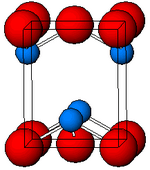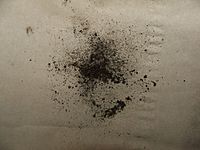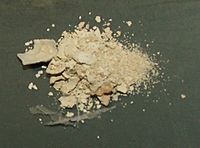Tin(II) oxide facts for kids
Quick facts for kids Tin(II) oxide |
|
|---|---|
 |
|
 |
|
 |
|
| IUPAC name | Tin(II) oxide |
| Other names | Stannous oxide, tin monoxide |
| Identifiers | |
| CAS number | |
| PubChem | |
| EC number | 244-499-5 |
| RTECS number | XQ3700000 |
| SMILES | O=[Sn] |
|
InChI
InChI=1S/O.Sn
|
|
| Properties | |
| Molecular formula | |
| Molar mass | 0 g mol-1 |
| Appearance | black or red powder when anhydrous, white when hydrated |
| Density | 6.45 g/cm3 |
| Melting point | |
| insoluble | |
| −19.0·10−6 cm3/mol | |
| Structure | |
| Crystal structure | tetragonal |
| Thermochemistry | |
| Std enthalpy of formation ΔfH |
−285 kJ·mol−1 |
| Standard molar entropy S |
56 J·mol−1·K−1 |
| Hazards | |
| Flash point | Non-flammable |
| U.S. Permissible exposure limit (PEL) |
none |
| Related compounds | |
| Other anions | Tin sulfide Tin selenide Tin telluride |
| Other cations | Carbon monoxide Silicon monoxide Germanium(II) oxide Lead(II) oxide |
| Except where noted otherwise, data are given for materials in their standard state (at 25 °C, 100 kPa) | |
Tin(II) oxide, also known as stannous oxide, is a special kind of chemical compound. Its chemical formula is SnO. This means it is made of one tin atom and one oxygen atom. In this compound, tin has a "charge" or oxidation state of +2, and it combines with oxide ions (which are oxygen atoms with a negative charge).
Contents
What is Tin(II) Oxide Like?
Tin(II) oxide usually looks like a dark blue-black solid. Sometimes, it can be red, but this red form is not as stable. If you heat it in the air, it will burn with a cool green flame. When it burns, it changes into another compound called tin(IV) oxide.
This compound is also a "reducing agent." This means it can give away electrons to other chemicals, helping them change. Tin(II) oxide is not as common as tin(IV) oxide. It can dissolve in acids, forming a clear liquid.
How is it Made?
Scientists can make tin(II) oxide in a lab. One way is to mix sulfuric acid with tin. This creates a substance called tin(II) sulfate. Then, they react the tin(II) sulfate with sodium hydroxide. This makes a wet form of tin(II) oxide. When this wet form is heated, the water goes away, leaving behind the dry tin(II) oxide.
What is it Used For?
Tin(II) oxide has a few interesting uses:
- It is used in touchscreens, which are the screens you tap on your phone or tablet.
- It helps make a special type of glass called ruby glass. This glass gets its beautiful red color from tiny bits of gold mixed into it.
Related Pages
Images for kids


